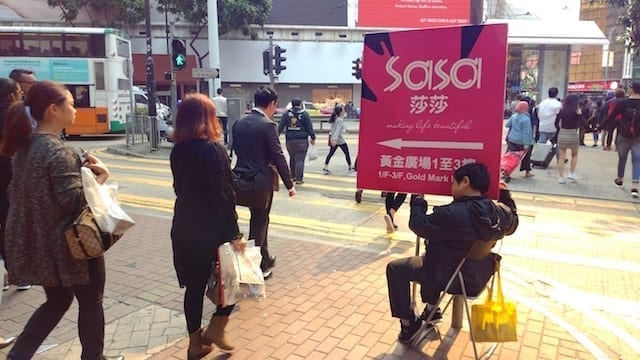

Leaders of businesses that have interests in China generally do not like to talk politics but the chairman of Hong Kong cosmetics chain Sa Sa International is an exception. He said Thursday that China’s tighter border security and Beijing’s rocky ties with South Korea have taken a toll on Sa Sa.
With the Chinese economy slowing, Sa Sa has been filling its shelves with mass-market cosmetics products from South Korea to cater to price-sensitive Chinese tourists. About 21% of the company’s products come from South Korea, more than doubled from last year, but that strategy will change soon.
“The THAAD (Terminal High Altitude Area Defense) missiles have affected the sales of our key growth driver — Korean products,” Sa Sa Chairman Simon Kwok Siu-ming told reporters on Thursday, referring to the deployment of a U.S. anti-missile system in South Korea that has strained relations between Beijing and Seoul.
Kwok added that the company would switch to selling more low-cost cosmetics from Taiwan and Japan instead.
But this change in strategy comes at a cost. Sa Sa saw a 2.8% drop in average spend per purchase despite a 2.9% growth in transaction volume. “Gone is the trend of conspicuous gifting. Chinese customers are shopping for self-consumption these days,” Kwok said.
Security at Chinese borders has also been reportedly tightened ahead of an expected visit by President Xi Jinping to mark the 20th anniversary of the territory’s handover to Chinese rule on July 1.
“If you asked me in May, I’d expect a rebound in retail sales in Hong Kong. Now, the market is at most stabilizing but with the recovery slowing,” Kwok said. He added that more stringent border checks have discouraged mainlanders to shop in Hong Kong. “I hope the impact is only short-lived.”
Sa Sa operates a growing sales network of some 280 shops in Hong Kong, mainland China, Singapore, Malaysia and Taiwan. Its profit dropped 14.8% to 326.7 million Hong Kong dollars ($41.9) in the year ended in March from a year ago.
Turnover slipped 0.6% to HK$7.75 billion as retail sales in Hong Kong and Macau, both of which accounted for 80% of the total, remained flat. Its sales on the mainland fell 4% on the year.
Investors reacted negatively to Sa Sa’s results, sending its shares 8.3% lower to a one-month low of HK$3.32. It proposed a final dividend of HK$0.08 per share, bringing its annual dividend to HK$0.17 per share, down 28% from a year ago.
The company said it would not pay a special dividend for the first time since 2002 due to hefty costs required to relocate its warehouse in Hong Kong and HK$35 million it expects to spend on upgrading its e-commerce platform.
Sa Sa’s e-commerce sales grew 9.5% to HK$475 million last year, contributing to about 6% of total sales. But the company, which operates its own online sales platform, started to hike prices from April in a bid to contain losses in e-commerce. It has also doubled the minimum spend for free delivery to 530 yuan ($78) per order.
“Our platforms were selling too cheaply before and we have to survive,” said Kwok. Inefficiency has been the “biggest weakness” of Sa Sa’s online platform as it would typically take nine to 10 days for goods to be delivered. “Our target is to make it happen in seven days,” he added.